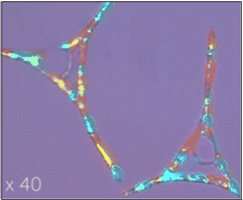Slowly cooling oil droplets in a soapy solution, have been found to shape-shift a variety of different regular geometric forms, from octahedrons and hexagons to triangles and fibres. The process is reversible and the usual spherical droplets are obtained on warming up. Stoyan Smoukov, Head of the Active and Intelligent Materials Lab, together with researchers at the University of Sofia, Bulgaria, have identified a new mechanism that the change in this first bottom-up method for producing a large number of geometric shapes by a phase transition.
The dynamics are on the seconds to the minutes timescales, and though the system is artificial and very simple, it often resembles the symmetry-breaking morphogenesis behaviour of complex living things in nature. In contrast to many previous top-down methods, this bottom-up method for assembling complex forms is both material- and energy-efficient and does not require expensive equipment to make them.
The results, reported in the journal Nature, could have potential applications in pharmaceuticals, paints, and consumer products such as shampoo. The fundamentals of the shape generation and could enable novel approaches for construction of complex structures from simple components. They are also expected to have far-reaching implications for active research fields, such as elastocapillarity, phase changes in confinement, and surface and bulk nucleation.
The researchers are exploring links between dynamic processes in the biological and the non-biological world. The discovery of the physical principles behind this complex behaviour in a simple system with only three components allows one to better understand the mechanisms of symmetry breaking and further engineer this process of artificial morphogenesis.
N. Denkov, S. Tcholakova, I. Lesov, D. Cholakova and S.K. Smoukov, "Self-shaping of oil droplets via the formation of intermediate rotator phases upon cooling", Nature >strong>528, 392 (2015)

